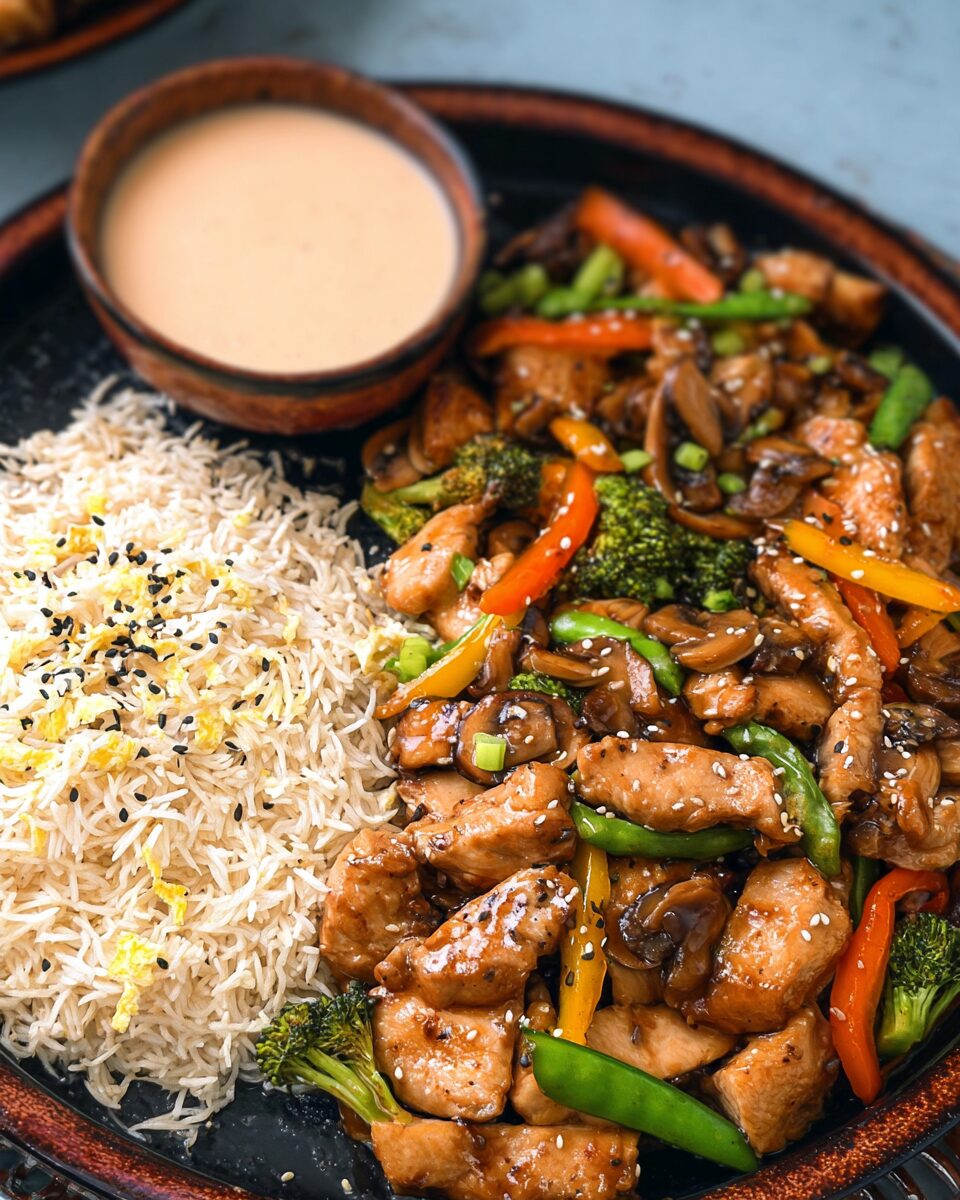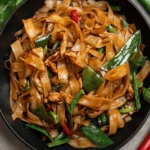The sizzling sound of hibachi chicken cooking in butter, soy sauce, and garlic instantly transports you to your favorite Japanese steakhouse — no reservation required. This dish offers bold flavors with minimal ingredients, capturing the heart of hibachi-style cuisine with just a few simple pantry staples.
Served with crispy sautéed vegetables, fragrant fried rice, and a luscious Yum Yum sauce, this Benihana-inspired dinner brings all the flair and flavor of teppanyaki cooking right to your stovetop. Whether you’re entertaining guests or just craving something special on a weeknight, this one-skillet wonder is ready in under 45 minutes and packed with satisfying textures and flavors.
Full Recipe:
For Hibachi Chicken:
-
2 Tbsp butter
-
1.5 lbs boneless skinless chicken breast, cut into bite-sized chunks
-
3–4 garlic cloves, finely chopped
-
2 Tbsp soy sauce
-
Black pepper, to taste
For Hibachi Vegetables:
-
1.5 Tbsp butter
-
1 small onion, cut into chunks
-
1 zucchini, cut into chunks
-
1 large carrot, sliced
-
8 oz mushrooms, sliced
-
1.5 Tbsp soy sauce
-
Black pepper, to taste
For Hibachi Fried Rice:
-
4 Tbsp butter
-
1 large carrot, finely chopped
-
1 cup peas
-
¼ cup corn (optional)
-
3 garlic cloves, finely chopped
-
2 tsp ginger, finely chopped
-
4 cups cold, leftover rice
-
2 tsp soy sauce
-
1 tsp sesame oil
-
2 eggs
-
Salt, to taste
For Yum Yum Sauce:
-
1 cup mayonnaise
-
1.5 Tbsp tomato paste
-
1 Tbsp melted butter
-
1 tsp honey
-
1 tsp paprika
-
½ tsp garlic powder
-
2 Tbsp water
Directions:
Hibachi Chicken:
-
Heat 2 Tbsp butter in a large skillet over medium-high heat.
-
Add diced chicken and sauté for 4–5 minutes.
-
Stir in garlic and cook another 3–4 minutes.
-
Add soy sauce and black pepper. Cook until chicken is golden and cooked through. Plate and set aside.
Hibachi Vegetables:
-
In the same skillet, melt 1.5 Tbsp butter.
-
Add onion, zucchini, carrot, and mushrooms.
-
Sauté until vegetables are slightly tender, about 5–6 minutes.
-
Add soy sauce and pepper. Stir-fry for another 2–3 minutes until vegetables are crisp-tender. Plate and set aside.
Hibachi Fried Rice:
-
In the same skillet, melt 4 Tbsp butter over high heat.
-
Add carrots, peas, and corn. Sauté for 3–4 minutes.
-
Add garlic and ginger; cook for 1 more minute.
-
Add cold rice, soy sauce, and sesame oil. Stir-fry everything together.
-
Push rice to the sides of the skillet, crack eggs into the center, season with salt, and scramble.
-
Mix scrambled eggs into the rice evenly.
Yum Yum Sauce:
-
Combine all sauce ingredients in a bowl.
-
Whisk until smooth and creamy.
Serve Hibachi chicken with sautéed vegetables, fried rice, and Yum Yum Sauce.
Prep Time: 15 minutes | Cooking Time: 25 minutes | Total Time: 40 minutes
Kcal: 510 kcal (approx.) | Servings: 4 servings
Recipe Overview
Hibachi Chicken is one of those iconic restaurant-style meals that feels like a celebration on a plate. With its sizzling sear, garlicky aroma, buttery glaze, and savory simplicity, it’s no wonder this dish has made its way from the hotplates of Japanese steakhouses into the kitchens of home cooks around the world. But it’s more than just chicken — it’s an experience. Paired with sautéed vegetables, flavorful fried rice, and the ever-popular Yum Yum sauce, this dish captures the magic of dining out, right in your own home.
What’s wonderful about Hibachi Chicken is its approachability. Even though it originates from a high-heat, theatrical dining tradition, it doesn’t require any fancy tools or advanced culinary skills. A large skillet or wok, a handful of staple ingredients, and you’re well on your way to creating a crowd-pleasing dinner that tastes anything but ordinary.
History and Origin
The word “hibachi” literally translates to “fire bowl” in Japanese — “hi” meaning fire, and “bachi” meaning bowl. Traditionally, hibachis were small, portable heating devices made from cast iron and filled with charcoal, used more for heating than cooking. Over time, especially in Western adaptations, the term evolved to refer to the high-heat flat grills used in Japanese steakhouses.
Interestingly, what we commonly call “hibachi” in the United States is more closely related to teppanyaki-style cooking, where ingredients are grilled on a large, flat iron surface in front of diners. Restaurants like Benihana popularized this experience in the 1960s and 70s, offering not only flavorful grilled meats and veggies but also an entertaining show, complete with knife tricks and flaming onions.
Hibachi Chicken, as we know it today, is a Westernized interpretation. It’s less about sticking strictly to traditional Japanese techniques and more about capturing that bold, seared flavor with minimal ingredients — usually just butter, garlic, soy sauce, and pepper. Despite its simplicity, this dish pays homage to the hibachi concept: fast, high-heat cooking that celebrates freshness and flavor.
Variations and Adaptations
The core of Hibachi Chicken — diced chicken quickly seared in butter and soy sauce — is incredibly versatile. Across Japanese steakhouses and home kitchens alike, you’ll find a range of delicious interpretations.
In Japan, you may encounter a simpler version where chicken is grilled with little more than salt and a splash of soy, perhaps served over rice with pickled vegetables. In contrast, American hibachi restaurants often elevate the dish with elaborate fried rice, mixed vegetables, and multiple dipping sauces.
If you’re exploring adaptations, here are a few creative takes:
-
Protein Swaps: Swap the chicken for steak, shrimp, tofu, or scallops. Each brings its own unique texture and flavor to the hibachi plate.
-
Sauce Tweaks: While Yum Yum sauce is a fan favorite, some variations include ginger sauce or spicy mustard sauce as alternative pairings.
-
Veggie Mix-ins: Broccoli, baby corn, bell peppers, or even edamame can be added to the mix of stir-fried vegetables.
-
Low-carb or keto options: Replace rice with cauliflower rice and reduce the soy sauce or swap it for coconut aminos to lower sodium.
Nutritional Information
One of the strengths of Hibachi Chicken is its balanced nutrition. While it’s indulgent thanks to the butter and accompanying sauces, it can easily be modified for lighter diets.
Here’s a rough breakdown per serving (based on one-fourth of a full recipe with chicken, veggies, rice, and a portion of Yum Yum sauce):
-
Calories: ~510 kcal
-
Protein: ~36g
-
Carbohydrates: ~35g
-
Fat: ~24g
-
Saturated Fat: ~8g
-
Cholesterol: ~180mg
-
Sodium: ~950mg
-
Fiber: ~4g
-
Sugars: ~4g
If you’re monitoring sodium intake, the soy sauce and Yum Yum sauce are the primary contributors. Using low-sodium soy sauce and reducing the amount of added sauce can make a big difference. Similarly, switching to olive oil instead of butter for cooking will lower saturated fat.
Serving Suggestions and Pairings
Hibachi Chicken is a full meal on its own, but it shines even more when thoughtfully plated and paired. A traditional hibachi plate includes the trifecta: protein, vegetables, and rice. But don’t let that limit you!
Here are some creative serving ideas:
-
Bento Box-Style: Serve Hibachi Chicken alongside a small portion of seaweed salad, a few slices of tamagoyaki (Japanese rolled omelet), and pickled ginger for a fun Japanese lunch box vibe.
-
Sushi Night Companion: Make Hibachi Chicken the warm entrée at a sushi dinner party — a delicious contrast to cool rolls and sashimi.
-
Wrap it Up: Try stuffing the chicken and veggies into lettuce wraps with a drizzle of Yum Yum sauce for a light and modern twist.
-
Drink Pairings: A cold Japanese beer like Sapporo or Asahi pairs beautifully with the rich, savory flavors. Prefer wine? Go with a lightly chilled Pinot Noir or a dry Riesling. For non-alcoholic options, a matcha iced tea or sparkling yuzu soda offers refreshing contrast.
Tips and Tricks for Success
Cooking hibachi-style at home may seem intimidating, but it’s actually quite simple — as long as you keep a few key tips in mind:
-
Use High Heat: The magic of hibachi lies in the quick sear. A hot pan ensures the chicken browns beautifully without steaming.
-
Don’t Overcrowd: If your skillet isn’t big enough, cook in batches. Overcrowding the pan traps steam and prevents that essential caramelization.
-
Prep Everything First: Hibachi cooking is fast. Have all your ingredients chopped, sauces measured, and tools ready before you turn on the heat.
-
Cold Rice Is Key: Fried rice works best with rice that’s been chilled. Freshly made rice will turn mushy and clump together.
-
Get the Sauce Right: The Yum Yum sauce is a star in this dish. Make it ahead of time and let it chill — the flavors deepen the longer it sits.
-
Butter is Flavor: While oil can work, butter is what gives hibachi its signature richness. Use it generously (but not excessively) for that restaurant-style finish.
Potential Health Benefits
While Hibachi Chicken leans into comfort food territory, it does include several wholesome components:
-
Lean Protein: Chicken breast is high in protein and low in fat, supporting muscle repair and satiety.
-
Vegetables: Zucchini, mushrooms, carrots, and onions provide fiber, antioxidants, and a range of vitamins including A, C, and B-complex.
-
Garlic & Ginger: Both have anti-inflammatory and immune-boosting properties and add layers of flavor without extra calories.
-
Eggs: In the fried rice, they add protein, healthy fats, and important nutrients like choline and B12.
-
Sesame Oil: Though used sparingly, sesame oil is rich in antioxidants and healthy fats.
If you’re conscious about health, the dish is easily customizable to reduce calories or sodium, or to increase the veggie content.
Conclusion
Hibachi Chicken is the kind of meal that brings people together — it’s comforting, flavorful, fun to cook, and incredibly satisfying. It’s a dish that lets you bring the energy of a restaurant dinner right into your home kitchen, with sizzling sounds, delicious aromas, and mouthwatering flavor in every bite.
Whether you’re cooking for your family on a weeknight or entertaining friends on the weekend, this recipe is a guaranteed hit. And the best part? It’s versatile, customizable, and easy enough for any level of cook to master. So grab your skillet, prep your ingredients, and turn your stove into your own personal hibachi grill.





